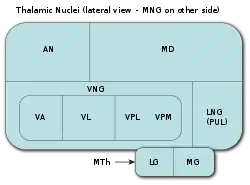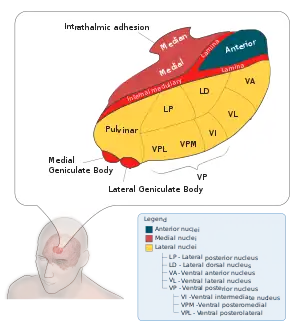Ventral posterolateral nucleus
| Ventral posterolateral nucleus | |
|---|---|
 Thalamic nuclei: MNG = Midline nuclear group AN = Anterior nuclear group MD = Medial dorsal nucleus VNG = Ventral nuclear group VA = Ventral anterior nucleus VL = Ventral lateral nucleus VPL = Ventral posterolateral nucleus VPM = Ventral posteromedial nucleus LNG = Lateral nuclear group PUL = Pulvinar MTh = Metathalamus LG = Lateral geniculate nucleus MG = Medial geniculate nucleus | |
 Thalamic nuclei | |
| Details | |
| Part of | Ventral posterior nucleus |
| Identifiers | |
| Latin | nucleus ventralis posterolateralis thalami |
| NeuroNames | 344 |
| NeuroLex ID | birnlex_737 |
| TA98 | A14.1.08.641 A14.1.08.656 |
| TA2 | 5692 |
| FMA | 62200 |
| Anatomical terms of neuroanatomy | |
The ventral posterolateral nucleus (VPL) is a nucleus of the thalamus. Together with the ventral posteromedial nucleus (VPM), ventral posterior inferior nucleus (VPI) and ventromedial posterior nucleus (VMpo), it constitutes the ventral posterior nucleus. There is uncertainty in the location of VMpo, as determined by spinothalamic tract (STT) terminations and staining for calcium-binding proteins, and several authorities do not consider its existence as being proved.[1]
Input and output
The VPL receives information from the neospinothalamic tract and the medial lemniscus of the posterior column-medial lemniscus pathway. It then projects this sensory information to Brodmann's Areas 3, 1 and 2 in the postcentral gyrus. Collectively, Brodmann areas 3, 1 and 2 make up the primary somatosensory cortex of the brain.
Additional images
 Thalamus
Thalamus The sensory tract.
The sensory tract.
References
- ↑ Willis et al The Journal of Pain 2002;3:79-94; Graziano and Jones, The Journal of Neuroscience 2004;24:248–256